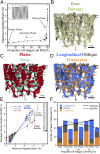Bone-inspired microarchitectures achieve enhanced fatigue life
- PMID: 31740616
- PMCID: PMC6900498
- DOI: 10.1073/pnas.1905814116
Bone-inspired microarchitectures achieve enhanced fatigue life
Abstract
Microarchitectured materials achieve superior mechanical properties through geometry rather than composition. Although ultralightweight microarchitectured materials can have high stiffness and strength, application to durable devices will require sufficient service life under cyclic loading. Naturally occurring materials provide useful models for high-performance materials. Here, we show that in cancellous bone, a naturally occurring lightweight microarchitectured material, resistance to fatigue failure is sensitive to a microarchitectural trait that has negligible effects on stiffness and strength-the proportion of material oriented transverse to applied loads. Using models generated with additive manufacturing, we show that small increases in the thickness of elements oriented transverse to loading can increase fatigue life by 10 to 100 times, far exceeding what is expected from the associated change in density. Transversely oriented struts enhance resistance to fatigue by acting as sacrificial elements. We show that this mechanism is also present in synthetic microlattice structures, where fatigue life can be altered by 5 to 9 times with only negligible changes in density and stiffness. The effects of microstructure on fatigue life in cancellous bone and lattice structures are described empirically by normalizing stress in traditional stress vs. life (S-N) curves by √ψ, where ψ is the proportion of material oriented transverse to load. The mechanical performance of cancellous bone and microarchitectured materials is enhanced by aligning structural elements with expected loading; our findings demonstrate that this strategy comes at the cost of reduced fatigue life, with consequences to the use of microarchitectured materials in durable devices and to human health in the context of osteoporosis.
Keywords: additive manufacturing; bone; microarchitecture; microarchitectured materials; osteoporosis.
Conflict of interest statement
The authors declare no competing interest.
Figures



Comment in
-
Reply to Zadpoor: Fatigue mechanisms observed in bone provide insight to microarchitectured materials.Proc Natl Acad Sci U S A. 2020 Mar 31;117(13):6986. doi: 10.1073/pnas.2000331117. Epub 2020 Mar 3. Proc Natl Acad Sci U S A. 2020. PMID: 32127470 Free PMC article. No abstract available.
-
On bone fatigue and its relevance for the design of architected materials.Proc Natl Acad Sci U S A. 2020 Mar 31;117(13):6985. doi: 10.1073/pnas.1922857117. Epub 2020 Mar 3. Proc Natl Acad Sci U S A. 2020. PMID: 32127474 Free PMC article. No abstract available.
References
-
- Zheng X., et al. , Ultralight, ultrastiff mechanical metamaterials. Science 344, 1373–1377 (2014). - PubMed
-
- Berger J. B., Wadley H. N., McMeeking R. M., Mechanical metamaterials at the theoretical limit of isotropic elastic stiffness. Nature 543, 533–537 (2017). - PubMed
-
- Fleck N. A., Deshpande V. S., Ashby M. F., Micro-architectured materials: Past, present and future. Proc. Roy. Soc. A Math. Phy. Eng. Sci. 466, 2495–2516 (2010).
-
- Schaedler T. A., Carter W. B., Architected cellular materials. Annu. Rev. Mater. Res. 46, 187–210 (2016).
Publication types
MeSH terms
Substances
Grants and funding
LinkOut - more resources
Full Text Sources
Medical

